How to Improve Your Google Rankings (Without Getting Penalized)

Top Google rankings are a pinnacle of online business success.
According to Backlinko, the first result on Google gets 31.7 percent of all clicks — while results on the second page receive just .78 percent of clicks.
I’ve talked to a lot of business owners and managers – newbies and veterans alike – who have struggled to unlock the secrets of how to improve their Google ranking without getting penalized.
I wish I could tell you there’s a magic button that ranks your site #1 without fail.
The truth is, it takes resourcefulness, dedication, persistence, and creativity. This is especially true because of the constantly changing nature of Google’s algorithm.
While there’s no magic bullet, there are steps you can take to soar to the top of a search engine results page (SERP).
I learned this the hard way; but luckily, you don’t have to.
I’m going back to basics with on-page SEO to help you understand the new SEO rules, learn how to optimize for both humans and search algorithm crawlers, and to master on-page and off-page SEO.
Here are the steps I will cover in this guide:
Step #1: Get to Know the Google Algorithm
Google executives like Gary Illyes and John Mueller confirm Google constantly changes its algorithm, even though most of these changes aren’t publicly announced.

Moz estimates there are 500 to 600 Google algorithm changes per year!
While Google used to share major update announcements, the exact inner workings of the algorithm are still unknown. The majority of information is just speculation from industry professionals.
After all, if everyone knew exactly how to rank in the first position without penalties for shortcuts or black hat SEO strategies, Google wouldn’t succeed in ranking only the best results. Anyone could hack their way to the top without putting in the work.
Not only would this make it hard for honest people like you and me to succeed, but it would also seriously compromise Google’s mission statement:
Google’s mission is to organize the world’s information and make it universally accessible and useful.
The best knowledge we have of Google’s algorithm comes in the form of major algorithm updates like:
- Page Experience Update (June 2021): This update affected Core Web Vitals, organic results, and News alerts.
- Core Update (December 2020): This update focused on content quality and relevance.
- Mobile-first update (July 2019): Googlebot now looks at all websites as a smartphone, prioritizing sites that work well on mobile devices.
- Mobile-friendly update (April 2015): Favoring websites with mobile-friendly versions and setting the stage for future penalties if sites don’t comply.
- Pigeon (July 2014): Worked to integrate local search results like Google Maps.
- Hummingbird (August 2013): Aimed to understand the context and intent behind a user’s search instead of just looking at the literal words they typed.
- Penguin (April 2012): Targeted spammers and sites that buy unnatural links to boost their rankings.
Not to mention Panda, Google EMDs (exact match domain names), and the Private Blog Network (PBN) deindexing updates. Then there’s Phantom, which first appeared in May 2013 and is believed to have been updated four times – but has never actually been confirmed by Google.
How are you supposed to keep track of all these Google updates?
There are some great resources to help. Moz’s Google Algorithm Change History is an awesome database that organizes updates chronologically. Check out Google Webmaster Central, too.
Check out the video below to learn more about my strategies for link building, on-page SEO, and user metrics when trying to rank on Google.
Now that we’ve covered the basics of the algorithm, let’s get down to those actionable strategies I mentioned earlier.
Step #2: Assess Your Current Google Ranking
To improve your Google ranking, you need to know where you stand. This is true even for new sites. Thankfully, there are several tools to help.
Use Ubersuggest to Check Your Site’s Keyword Rank
If you’ve been targeting specific keywords in page content, use my tool Ubersuggest to assess your rank.
Login, then use the “Traffic Overview” under the competitor report. Type in your domain, and you’ll see a list of SEO keywords your rank for, top pages, and an overview of your SEO keywords ranking.
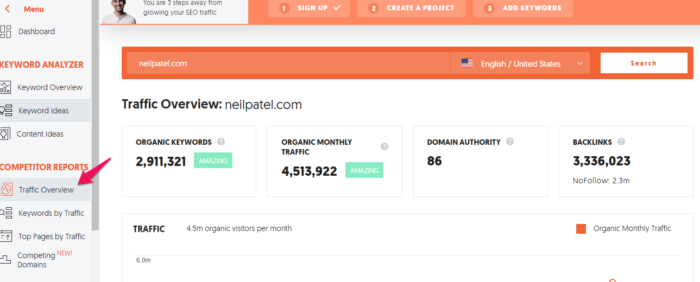
Scroll down to view the “SEO Keywords” chart, which tells you where you rank for main keywords.
Check Your Site Speed
Next, it’s important to check site speed, as this is still an important Google ranking factor.
If your site is slow, you have little chance of a high search position. It will affect your ability to convert and sell new customers, too.
Walmart experienced a sharp decline in conversions when its page load times increased from one to four seconds.
If this happens, it doesn’t matter what your on-page SEO, meta description, or title tags are. The search algorithm will punish you, even if you’re a giant like Walmart.

That’s why it’s important to run your own site speed test to figure out how to improve Google rankings. There are dozens of tools that can help you do this. Some of my favorites are:
Here’s how to test your page content speed with Pingdom.
Go to tools.pingdom.com and type in your URL. Choose the location you’d like to test from and click “Start Test.”

Quick Sprout registers a performance grade of 81. As long as your site registers over 50, that’s a good start.
If you get a performance grade of less than 50, your page content is really slow and you need to work on improving it.

Check the page load time, too.
Quick Sprout is doing pretty well at 1.89 seconds. Aim for under 2 seconds for a really fast site and under one second for mobile devices.
Remember, a load time of more than a few seconds could cause you to lose a significant amount of site traffic.
Check Your Site’s Health
After looking at keyword search engine rank and site speed, assess the overall health of your site before you start to optimize.
Have you experienced a sudden drop in organic traffic after months or years of consistency?
Are you wondering whether Google has deindexed (or banned) your site?
There are a lot of great tools to help piece together this puzzle. Try the MxToolBox Domain Health Report tool to check for major issues in five different categories: general site problems, blacklist, mail server, web server, and DNS.

Just click the box for each category to see specific errors and warnings. From there, you can work one-by-one to fix them.

If you want to check if you’ve been penalized by one of the major algorithm updates, check out FE International’s Website Penalty Indicator tool.

You’ll see a graph that shows your site’s traffic in relation to rollouts of major updates. This comparison takes you one step closer to knowing if an update directly affected your site.

To check for a Google penalty, login into Google Search Console and look for the “Security & Manual Actions” report. This will tell you if Google has taken a manual action against your site.
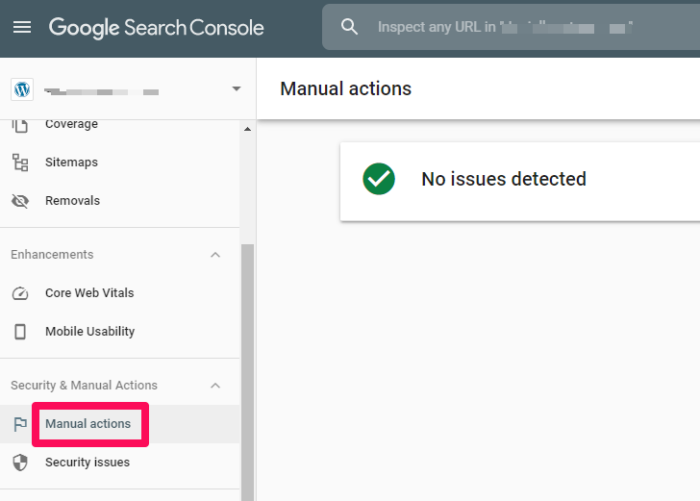
Note that this report will only show if a human reviewer has determined your site breaks Google’s quality guidelines — it won’t tell you if a Google Algorithm update penalized your site.
If you do have a manual penalty, fix the issue (this guide on how to recover from a Google penalty can help), then submit a reconsideration request with Google.
Step #3: Track and Measure the Right SEO Metrics
Next, it’s time to track some vital metrics of your site to find out what other factors you need to improve. Here are the most important metrics to assess.
Organic Traffic
It’s important to know how visitors find your site via Google. In the past, organic search drove most website visitors, crushing non-organic channels like paid search and social media.
Today, social media, email, and paid ads often lead the pack in driving organic traffic — but that can vary drastically by industry.
To find out how many visitors reach your site, log in to your Google Analytics account and check out the acquisition channels report. This helpful Google Analytics guide will guide you.
Organic Traffic Conversions
In addition to analyzing search traffic, it’s worth paying attention to the keywords that generate traffic for your site. This is harder to see than it used to be, but is still possible.
You can do this with Google Search Console (formerly Google Webmaster Tools). It can tell you how many clicks you get for certain keywords in organic search results.
Keyword Ranking for Transactional Keywords
The number one keyword research mistake is not spending enough time focusing on transactional keywords.
That’s because commercial keywords are the ones that drive revenue. To improve your search engine rankings and make money, you need to understand the difference between commercial and informational keywords to improve Google rankings.
If all of your keywords are informational, you will still generate organic traffic, but it may be difficult to convert those visitors to buyers or people who share on social media.
The reason is because of visitors who search for informational keywords like:
- How to clear acne with home products
- How to install WordPress
- Make money online for free
- Free ebook download
- Top 10 free article spinners
If they’re not in the buying mood, they want you to speak their language; the search engine language of free. Now, these terms can drive traffic and a solid sales funnel will convert some of those people — but not many.
In contrast, there are people who use transactional keywords that show user intent, like:
- Best acne products
- Top 10 web hosting providers
- Web designers in NY
These folks are probably searching for a solution that they can buy.
If you’re in the e-commerce industry, you’ll hopefully already know that transactional keywords tend to convert well.
Keywords that have the words below as a prefix (before) or suffix (after) to the rest of the keyword phrase tend to do well:
- Buy
- Review
- Purchase
- Discount
- Coupon
- Deal
- Shipping
- Order
Earlier, I talked about the keywords that are sending you organic traffic. They should also be used in the meta description as well as on-page SEO (more on this later).
Here’s another example. Can you spot the difference between informational and transactional keywords?

Set Up An SEO Dashboard to Track These Metrics
I recommend that you set up an SEO dashboard so that you can track all of the important metrics at any time.
Here’s how to set one up in Google Analytics.
If you have the cash to drop on SEO tools, go for it. If you are on a small budget, however, Google Analytics should serve you just fine.
In addition to setting up dashboards in Google Analytics, you can get even richer keyword data by connecting Google Search Console to Google Analytics. Here’s a complete guide on how to do that.
Step #4: Ensure Your Site is Mobile-Friendly (and Ready For a Mobile-First Google)
More than half of all website traffic comes from a mobile device. That means if you want to rank well, your site needs to perform well on mobile.
While some algorithm changes remain unclear, Google left nothing to the imagination when it comes to mobile. On January 10, 2017, the Google Webmaster Blog said:
Starting today, pages where content is not easily accessible to a user on the transition from the mobile search results may not rank as high.
Then in 2020, Google moved to “mobile-first indexing” which means Google looks at websites as a mobile device. If your site is hard to navigate, your ranking will be impacted.
Luckily, it’s pretty easy to see where you stand. Google’s Mobile-Friendly Test offers a quick way to determine if your site is mobile-friendly or on its way to Penaltyville.
Just type in your URL and click “RUN TEST.”

The results will give you a clear “yes or no” answer along with a list of the page loading issues it encountered. This way you can fix and optimize to ensure your mobile site running smoothly.

You’ll be able to look at page loading issues like redirection errors and pages where robots.txt blocked the Googlebot from crawling the page.
Google’s Search Console also has a Mobile Usability Report that will give you a list of your site’s mobile usability issues.
Tips to Make your Site Mobile-Friendly
If your site isn’t mobile-friendly, add this to the top of your to-do list.
- You can get a quick fix through services like Mobify or Duda Mobile.
- If your website is built on a popular CMS platform, like WordPress or Wix, most themes are mobile-friendly. You may need to update your site to the latest version to take advantage of these features.
- Make sure CTAs and form fields use large, easy to tap buttons.
- Don’t use popups that are impossible to close. Yes, pop-ups improve conversions, but they can also annoy users.

For additional SEO insight, check out Google’s tips for how to improve website ranking on mobile.
Mobile and Local SEO: An SEO Friendship
There’s a strong connection between mobile and local search. Google caters to hyper-local search, connecting consumers and brands as smoothly and quickly as possible.
That’s why you should make sure your Google My Business profile is up-to-date and comprehensive.
These profiles can be a deciding factor for someone who’s searching in your area, so claim and update your business listing ASAP if you haven’t. This also goes for other local listing sites, like Yelp, Facebook, Better Business Bureau, and more.
See HubSpot’s local business listings and directories list for a comprehensive look.
Step #5: Diagnose and Fix Your Current Google Penalties
Now that you understand your search ranking and have set up tracking for the most important metrics, it’s time to examine your site in detail and fix any current penalties.
This is fundamental; there is no point in promoting or building links to an unhealthy site. Before we dig in, I want to cover a few things that could get you a Google penalty.
Link Building has Changed
Bad links hurt your site. Use them and you can expect a Google penalty sooner rather than later.
That’s why it’s essential to think about how you generate links to your site.

The sentiment remains true today.
Here’s how. Start by identifying and eliminating unhealthy links.
Analyze Your Links
First, analyze inbound links to your site. There are several link analysis tools you can use to do this:
Let me walk you through a link analysis using SEOprofiler.
Sign up for a free account and go to Link Profiler → Backlinks. Let’s use problogger.net:

The results show the most important elements to look for when analyzing your backlinks:
- Unique Active Backlinks: This shows the number of links that directly or indirectly affect your Google ranking. “Unique” means that the links are from different IP addresses. That’s one way to identify a natural link. These links have been indexed by Google in the last 90 days.
- Nofollow links: Problogger has 10.2% nofollow links, which equals 1,522 backlinks from the total of 14,922. Google introduced the rel= “nofollow” tag in 2005 to stop spammy blog comments from artificially manipulating rankings. After the Google Penguin update was rolled out in 2013, it became essential to diversify your link profile. And as Matt Cutts mentioned, you need a mix of dofollow links (links that pass ranking value to search engines) and nofollow links (links that don’t pass ranking value).
- Industry: If you read the content of Problogger, you might think that its industry is “blogging” or “internet marketing.” But, when you look at this analysis, it turns out to be “media.” Knowing your industry can help you identify relevant links that will improve your backlink profile in the search algorithm used by the search engine.
- Link Influence Score: This shows how links from the website influence the search engine rankings of linked pages. The higher the score the better. As a very popular and influential site, Problogger’s score is a whopping 99%! Check your own site and see what your score is.
- Anchor Text: Click on the link in the left menu to access data for anchor text (anchor text is the text that becomes your link and points to your page) linking into your site. Google’s Penguin update was rolled out to prevent site owners from manipulating search results with exact match anchor text. If you want to stay under the search algorithm penalty radar, diversify your anchor text.

It’s also important to know which links are harmful to your site so that you can remove them. Harmful links include those that:
- Come from PR-n/a or PR0 websites
- Are mostly sitewide links
- Are from referring domain names with little traffic
- Come from sites on the same IP class address
- Come from web pages with a lot of external links
There are many free tools to help you identify unhealthy links. Two that I’ve tried include Monitor Backlinks and Linkquidator.
Moz has a detailed tutorial on which links can harm your site and what to do about it.
Remember to export the list of unhealthy links once you find them. That way, you can refer to them later.
Clean Up Your Link Profile to Avoid a Google Penalty
That’s the next step in cleaning up your link profile, and there are two ways to do it.
1. Request a Manual Link Removal: Visit the website where the unhealthy/unnatural links are coming from and contact the site owner. Ask the site owner to either remove your link (the better option) or add a nofollow tag to it.
If you have outsourced link building in the past, you can also contact the person who placed the links for you and ask that person to have the links removed. Here’s an excerpt from a post at Search Engine World to show how this works:

In this case, don’t ask the site owner to remove your links because they might assume you’re a spammer and ignore you. Instead, follow this tutorial from Search Engine Journal to learn the best way to contact webmasters about link removal.
2. Use Google’s Disavow Links Tool: If you’re unsuccessful in getting unhealthy links removed, your only option is to use Google’s own disavow links tool.
While manual link removal is best, this is a good second choice.
The disavow tool is part of Google Search Console. Once you open Search Console, you’ll see a list of all of your sites.
Go to the site for which you want to disavow links. This is what you’ll see:

When you check for unnatural links, you have the option to export the links that you find. If you have done this, upload the file and click “done.”
Like you, Google can’t actually remove the links as they don’t have access to the referring sites.
However, doing this authorizes Google to stop passing link juice (value) from those links to your page content.
3. Diversify Anchor Text Distribution: Anchor text can play a key role in improving or utterly destroying your search ranking. As I mentioned earlier, if you want a natural link profile, you have to diversify anchor text.
When distributing your anchor text, think about including these types:
Let’s assume your page content sells blue denim jeans. If your domain name is bluedenimjeans.com, how do you distribute your anchor text?
If you want to link three times from a particular site, it’s ideal to use this link profile:
- Anchor text 1: Bluedenimjeans.com site – target page: homepage
- Anchor text 2: denim jeans reviews online – target page: a page where you reviewed the item
- Anchor text 3: www.bluedenimjeans.com reviews – target page: your store
4. Avoid Over-Optimization: When you overuse anchor texts, it can result in over-optimization and can get you penalized. Geoff Kenyon suggests the percentage below:

To avoid anchor text over-optimization, follow these two guidelines:
- Avoid Excessive Keyword-Tich Anchor Text: If you want to link to your internal pages on a topic, like “link building strategies,” don’t use that same keyword phrase as your anchor text. Instead, use something like “learn more about link building” or a combination of a generic plus the exact keyword. Variety is key.
- Avoid Irrelevant Links: What’s the point of linking to your dog training site using “best golf trainer” as your anchor? It doesn’t make sense to improve Google rankings and could actually result in a Google penalty.
If you need a detailed guide on over-optimization, see How to Avoid Over Optimization For your Site.
Step #6: Improve Google Rankings with Keyword Research
Once you are rid of unnatural links, it’s time to improve on-page SEO the right way.
One essential element of an effective inbound marketing strategy is keyword research. You won’t get far without understanding how it works.
Learn How Your Audience Finds Your Site
To be effective, you need to pinpoint the keywords that your target audience is using to find your site. Here’s how that works.
Step #1: Visit Ubersuggest, Enter your Keyword and click Search.

Step #2: Click on Keyword Ideas
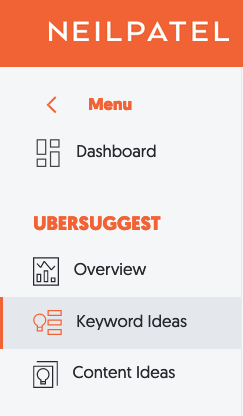
Step #3: Review Keywords and Search Volume for the Month
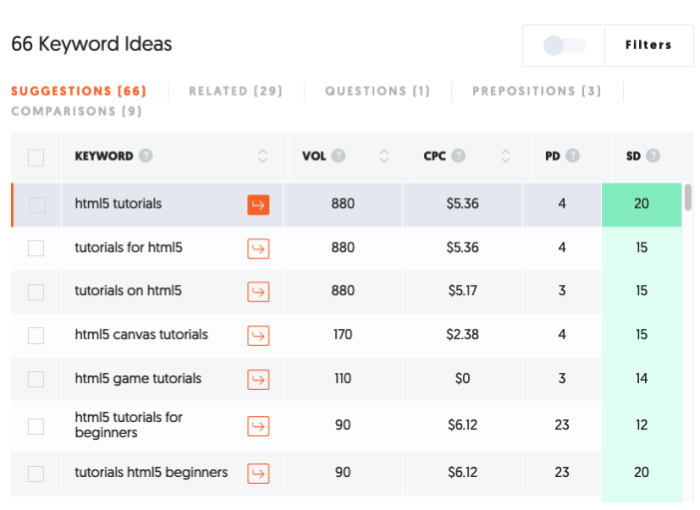
Here’s how that helps you.
When you research keywords, you’re getting firsthand information about your target audience, the information that they want to know, and how they want it.
For example, when someone searches for “html5 tutorials for beginners,” you know the searcher is a newbie who is searching for solutions and wants content that helps with this topic.
That can guide you to write headlines and content that ranks well in the Google search results.
It’s helpful to figure out the buyer personas and customer lifecycle of your target audience, so you understand what motivates them. Then, provide relevant page content that will help you increase your Google ranking.
Alexa can help you work out audience demographics, as in the example below for Upworthy.

Remember when I mentioned transactional and informational keywords?
When you do keyword research, you can easily see whether users are simply looking for information or ready to buy.
That’s called user intent, and here’s how it looks for the keyword research example used earlier.
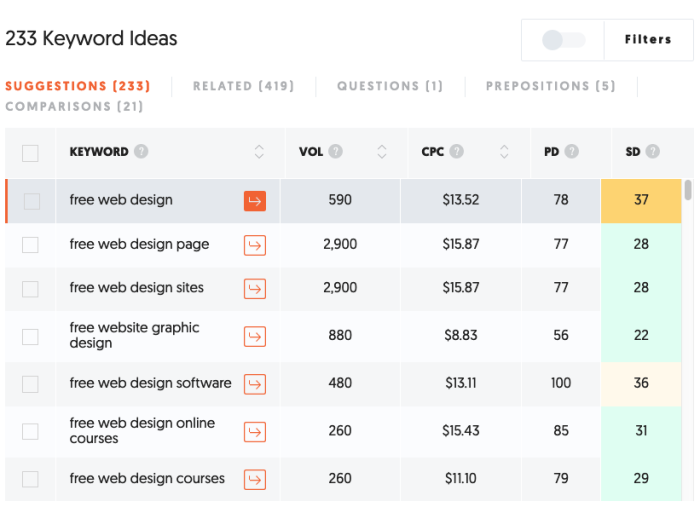
In this example, free web design is an example of an informational keyword. Free web design courses is an example of a transactional keyword.
You need both informational and transactional keywords in your page content to improve the Google rankings of your website.
It’s your job to educate, inform, inspire, and build interest before recommending a product.
Informational keywords can be used to build email lists and nurture prospects before offering a product for sale.
Also, don’t ignore long-tail keywords and questions.
The rise of voice search and BERT means long-tail keywords are more important than ever before.
This guide to intergrating long tail keyterms is a good place to start.
Spy On Your Competitors’ Keywords
If your competitors are ranking ahead of you in Google search results, it’s time to spy on them.
If the search algorithm likes them, you can learn and copy their strategies.
I like to use Google Keyword Planner for this because it gives me an accurate estimate of competitors’ keyword targets.
Let’s assume you’re in the “survival knife” sub-niche. One of the authority blogs you might spy on is survivallife.com.
On the Ubersuggest homepage, instead of inputting a seed keyword, simply type your competitor’s URL into the landing page box and click search.
Then scroll down the page until you see “SEO Keywords.” You will see the keywords that your competitor is targeting.
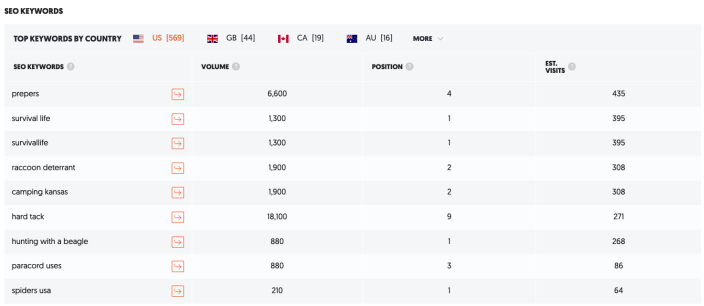
In addition to the keywords, other data includes:
- Volume: The number of searches the keyword has during a month.
- Position: The position the URL is ranked for in Google search.
- Estimated visits: The estimated traffic the webpage gets for the keyword.
For example, your competitor ranks number 1 for the term “survival life.” With the top spot, they receive roughly 395 visitors per month for the term. So, if you’re successful in overtaking them, you know what type of traffic to expect.
This works for any niche and can help you uncover hidden keywords that will help improve your ranking.
Boost Lower Ranking Keywords
If you find your web page on page two, how can you boost its ranking to the first page of Google?
You can use the skyscraper method, popularized by Brian Dean from Backlinko.
Find a post or article that’s ranking already, improve it, and promote it everywhere. This led to a 457% organic traffic increase for him.
If you want to do this for your topic (for example, “outsourcing guide for small business”), follow this simple guide:
- Extensively research the topic, including research studies.
- Identify the keywords to target using the strategies I shared with you in this post.
- Write a more in-depth post (that’s longer, more accurate, and actionable).
- Link out to authority blogs that are doing outsourcing well.
Make sure you write a powerful and clickable headline.
For example, if your first headline is:
Outsourcing Guide For Small Businesses
You can improve it like this:
The Complete Guide to Outsourcing for Small Businesses
An In-Depth Guide on How to Outsource for Small Businesses
X Ways Outsourcing Can Revolutionize Your Small Business
Contact the blog owners that you mentioned in your post and ask them to check it out. Hopefully, you’ll get a handful of authority sites to link back to you.
Use Keyword Analysis to Improve Content
Let’s get one thing straight.
There is no optimal ratio for placing keywords in an article.
However, knowing the right keywords to target is of the utmost importance. That’s the basis of keyword analysis.
Wordstream defines keyword analysis as:
The starting point and cornerstone of search marketing campaigns. By understanding what queries qualified visitors to your website type into search engines, search marketers can better customize their landing pages to increase conversion rates.
Unless you know the queries that qualified visitors type into Google, you’ll find it difficult to improve your ranking and conversion rates.
By now, you know how to do keyword research. That’s the easy part. The difficult part is knowing which keywords are bringing in organic traffic.
Ever since Google’s “Not Provided” update, this info has been hard to come by. This guide to unlocking Not Provided Keywords will help you recover some of the data. However, these days, it’s impossible to get a full view of what terms drive organic traffic.
You do want to pay attention to popular keywords, terms your competitors rank for, and Google’s “People also ask” questions.
Use this information to write on-page SEO content that matches user intent (remember that?). This will improve the Google ranking of your web pages.
How should you place your target keywords in the content?
Let’s assume you want to write an in-depth review on “best senior irons for seniors.” Here are some titles that you could use:
- Top 10 Best Senior Irons For Seniors
- Buyers’ Guide For The Best Senior Irons For Seniors
- Best Senior Irons For Seniors – The Ultimate Guide
To start your introduction, you could begin like this:
There are several senior irons in the marketplace. But knowing the right one for you is the most difficult decision. If you read this guide from start to finish, you’ll know the best senior irons for seniors that are affordable and reliable.
Or, you could start your introduction by asking a question:
Do you want to find the best senior irons for seniors? This page will not just tell you about the irons but will show how to use them to improve your golf game and provide practical tips on getting a huge discount for your purchase.
Do you see how I placed the target keyword in the first paragraph, without making it seem like spam?
As I’ve said before, target a specific keyword in a natural manner – don’t just try to make it look natural.
Step #7: Increase Google Ranking With On-Page SEO
Now that you know which keywords you want to target – and should be targeting – to maximize your performance, you’re equipped to make meaningful on-page SEO changes.
Backlinko has an excellent guide that breaks down on-page SEO factors that will earn you big points with Google and your visitors.
Let’s break down a few key considerations.
Optimize Title Tags
Title tags are still a big part of determining how your site will perform.
Make sure every title tag is descriptive, unique, and catered to your targeted keywords.
Avoid using the same keywords and title tags over and over. This way, you’ll diversify your opportunities while avoiding cannibalizing your own efforts.
Say that you’re an ecommerce company. A good formula for your product pages could be:
[Product’s Name] – [Product’s Category] | [Brand Name]
Like this:
Curly Hair Leave-in Conditioner – Hair Care | Diana’s DIY
Here are a few more title tag optimization tips:
- Use pipes ( | ) and dashes ( – ) between terms to maximize your real estate.
- Avoid ALL CAPS titles. They’re just obnoxious.
- Never keep default title tags like “Product Page” or “Home.” They trigger Google into thinking you have duplicate content, and they’re also not very convincing to users who are looking for specific information.
- Put the most important and unique keywords first.
- Don’t overstuff your keywords. Google increasingly values relevant, contextual, and natural strings over mechanical or forced keyword phrases.
- Put your potential visitors before Google – title tags can make-or-break traffic and conversions.
Keep in mind Google shows roughly 60 characters on a SERP, but don’t cut off if a longer title suits the page content. The search snippet title Google displays can be dynamic based on the search query.
So ultimately, you might be doing yourself a favor by getting more descriptive.
Plus, desktop snippet titles are limited by pixel width, while mobile display titles are typically longer.
Here’s an example from Hobo Web:

In the image above, Google displays as many characters as possible from the beginning. But in the image below, Google truncates the middle of the title to show the term “Hobo” at the end to show relevance to the user’s query.

While meta descriptions have negligible (if any) impact on your rankings, they still serve the important purpose of helping to determine your search snippet and adding an extra factor of uniqueness. This in turn can influence your click-through rate (CTR) from SERPs.
Check out this Kissmetrics article on making the most of meta descriptions for your CTRs.
Use Schema Markup (aka Structured Data Markup)
Schema markup can be thought of as extra “labels” on information that tells Google what your content means. For example, let’s say my name appears on an article, so Google displays my name in a SERP entry.
But if I use the right schema around my name in the article’s HTML, I can indicate to Google that I’m the author of the article, not just another term in a sea of indistinguishable words.

Not only does schema markup help Google understand your website, it also makes a massive difference in attracting traffic to your website.
Schema helps give users more relevant information in a visually organized and aesthetic way.
You can use schema tags to identify various types of SERP information, including:
- Articles
- Book reviews
- Events
- Local businesses
- Movies
- Products
- Restaurants
- Recipes
- Software applications
- TV episodes
- TV episodes with ratings
Google’s Structured Data Markup Helper is a great tool for implementing schema markup on your site to help you get featured snippets.
Featured Snippets
Featured snippets are featured more on mobile SERPs, which we discussed are more common in the U.S. than desktop searches.
The best part about them is that they push you to the number one result (also known as the coveted “position zero”) even if you’re not winning in the rankings otherwise.
It’s an easy way to push your result to the top of the page.
Here’s the best way to target them.
Think of a question in your industry that people are regularly typing into Google. Try something basic like, “What is digital marketing?” or “How to rank on Google?”
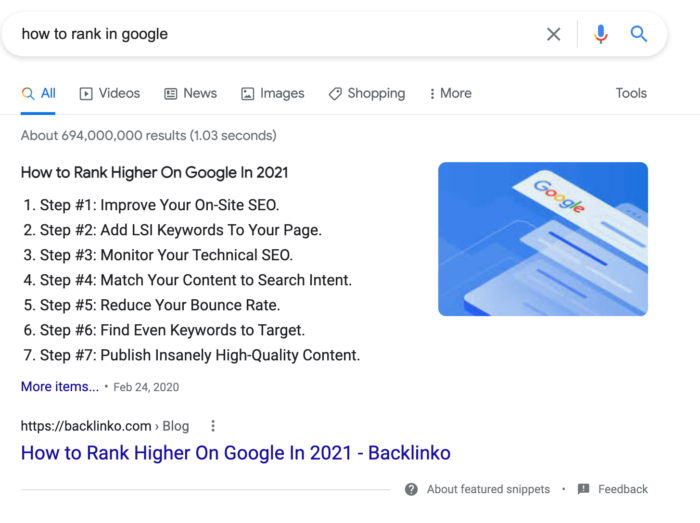
This article offers a step-by-step schema markup tutorial to get you started.
Create a Sitemap to Improve Google Rankings
A sitemap tells search engines about the organization of your site’s content.
That way, when Googlebot reads the file, it can more intelligently crawl your content. This helps make it more readily available for ranking on SERPs.
Sitemaps also provide valuable metadata about pages on your site like when they were last updated, how often you make changes, and how the page relates to other pages on your site.
You can use XML-sitemaps.com, a simple sitemap generator. If you use WordPress, there are several site map generator plugins as well.
Once you have your sitemap, check out my article on XML Sitemap to download your sitemap file, put it into the domain root folder of your website, and add the sitemap URL to your Google Webmaster account.
Now that we’ve covered some key on-page SEO factors, it’s time to discuss how to differentiate your brand from good to great with unique, strategic, and purposeful content.
Step #8: Use Keywords to Create Better Content
Although I’ve touched a bit on keyword research and placement already, in this section, we’ll look more at going leveraging those keywords that you’ve researched.
Sadly, a lot of people misunderstand the purpose keyword research and placement.
Even before Google rolled out their first Google Panda update, the best search marketers knew that quality, valuable, and useful content should target a particular group of people.
Optimize for informational keywords and improve your search ranking by writing resourceful and detailed content while supplementing it with descriptive meta description and title tags.
This process attracts raving fans, gets your content shared on social media platforms, and garners relevant and high-authority links naturally.
If you want to write resourceful and detailed content, follow the guide below:
Use Data-Driven Articles
According to ConversionXL, data-driven approach can increase your traffic.
Back up facts with accurate data so that people will see your content as authoritative and share it on social media, expanding your organic reach. This post on how to create and promote an infographic is an example of data-driven content.
Other examples of data-driven content include:
The Science of Productivity
5 Things You’re Measuring Incorrectly with Digital Analytics and What To Do About It
7 Proven Strategies To Increase Your Blog’s Traffic By 206%
The resources below will help you to backup your content with accurate data:
Aim to include newer stats — less than three years old is ideal.
You can even micro-target content. For example, if a blogger experiments with niche marketing, take it a step further and try niche marketing with an aged domain name, then write it up.
Use Storytelling
Stories can captivate your audience, evoke emotions, and improve your conversion rate.
Here’s how to tell a story that captivates your audience:
Begin with something unique: Start your story with a unique message that resonates with your audience. Ideally, this should connect with your audience’s questions or pain points.
Infuse Your Own Experiences: It’s called a story for a good reason. Use your own experiences (whether good or bad) as part of the message. No fakery allowed!
Jon Morrow used this on-page SEO content technique to grow his blog to 1,740 loyal subscribers in just seven days. Here’s the post that helped him connect with his audience: How To Quit Your Job, Move To Paradise, and Get Paid To Change The World.
Add a Call-to-Action (CTA): Every story must have an ending. Once you capture your readers’ attention, they expect you to share the solution. After all, your story is supposed to solve a problem, not nurture it.
Use a call-to-action link or button to lead people to your funnel and convert them. MatchOffice increased its conversion rate by 14.79% by changing its CTA copy.

Unbounce provides some more examples of actionable CTA buttons to replace your generic ones:

Write Shareable Headlines
Google has made a lot of changes to search rankings, but one element remains crucial: the headline.
If you write a shareable headline for your post, nothing can stop it from getting clicked, read, and shared by true fans.
Peep Laja of ConversionXL increased his conversion rate by changing the word “today” to “now” in a headline. It also helped him increase sales by 332%.
Headlines truly win the clicks.
Even if your web page is ranked at #1 in Google for page content, that doesn’t mean you’ll get the most clicks.
On-page SEO gets you in the running but the title can convert impressions to clicks.
Let’s search for the term how to outsource. Note that the most clickable headline is in position #2.

The perfect example of a website that uses shareable headlines to boost conversion rate is Upworthy.
I’ve used Buzzsumo to analyze Upworthy’s headlines. Check out the amazing number of shares the first article has racked up.

If I wanted to craft a better headline for my own content, here’s what I’d do:
Add numbers: Upworthy’s post was shared over 1.6 million times on Facebook because it has a definite number. If the headline was “Americans are Completely Wrong About This Mind-Blowing Fact,” I’m sure the total number of social media shares would be lower.
Here are some more examples. When I wrote this post, these headlines were ranked in the Google top 10 for their respective keywords. But, a simple tweak would result in a higher click-through rate.
Original headline:
SEO Basics For Optimizing Your Site
Let’s add some numbers:
- 6 SEO Basic Tips For Optimizing Your Site
- 12 SEO Basics You Need To Optimize Your Site
Original headline:
- Freelance Writing Tips For Stay-at-Home Moms
- Freelance Writing Jobs To Make Money
Let’s add some numbers
- 5 Freelance Writing Tips To Help Stay at Home Moms Make Money
- 10 Freelance Writing Jobs You Can Make Money From
Invoke Curiosity: Curiosity will cause people to click your headline, but do it with caution and make sure that you deliver on the promise of your headline with quality content.
For example, if your title is:
Top 7 Body Building Secrets You Didn’t Know
Then make sure that you reveal the ‘7’ secrets, and ideally, what you reveal needs to be new or unique.
Create a Multimedia Experience
While regular blogging is important, don’t settle there.
Hone in on your keywords to learn the questions that brought your visitors to your site. Then use diverse types of content to answer those questions, like:
- Videos
- Guides
- Ebooks
- Infographics
- Webinars
- Demos
- Checklists
- Email series
- Animated GIFs
- Comics
- Podcasts
For a comprehensive list, see HubSpot’s 20 types of lead generation content, as well as 14 types of experimental content that you should try out.

Abolish Duplicate Content
Use tools like Copyscape, SiteLiner, and Screaming Frog to make sure you’re not repeating yourself.
While the occasional duplicate content won’t destroy your rankings, you’ll be doing yourself a favor by showing Google each piece of content is original, relevant, and useful.
Once you have great on-page SEO content that includes informational and transactional keywords and tells a story that appeals to your audience, it’s time to build links the right way to improve Google rankings.
Step #9: Build Links the Right Way
Earlier, I showed you how to analyze links to your site using SEOprofiler.
Here’s another analysis I did for Business Insider’s site.
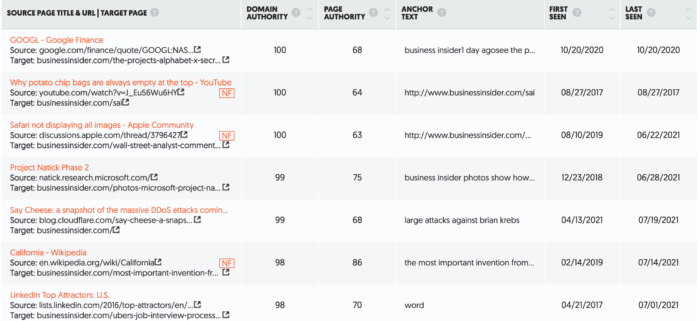
Note that it shows a range of different types of anchor text for inbound links.
That’s exactly what you need to build links the right way and improve Google rankings.
Here are some of the ways to do that and the types of links that you need.
Anchor text linking (in-text links): Anchor text links are simple links that appear within the content. See an example below…

I’ve found placing anchor text links “above-the-fold,” can increase conversion rates.
The anchor text linking strategy is mostly used when you’re looking to rank for a particular keyword.
You can use your target keyword as anchor text, but to be on the safe side and avoid penalties with the search algorithm, mix it up with generic keywords.
For example, if your primary keyword is digital camera reviews, when building your links from another site, link naturally like this: find the best digital camera reviews, top digital camera brands, etc.
A good mix is smart on-page SEO.
Internal Links: External links (that is links from other sites to yours) are important, but internal links are also important. Make sure to link to important internal pages using optimized anchor text when it makes sense.
Editorial Links: Creating useful content and sharing it through social media naturally results in valuable inbound links.
A good example is a post on 200 ranking factors that Brian Dean wrote. It’s been cited multiple times.

For Google, what other people say about you is much more important and relevant than what you say about yourself to improve Google rankings.
Over the years, I have created thousands of rich, data-driven, and useful blog content.
If you search for anything related to content marketing, Quick Sprout and neilpatel.com pop up, which means that I get a lot of editorial links.
Copyblogger links out to useful and relevant resource posts that contribute to the engagement that they already have with their audience.
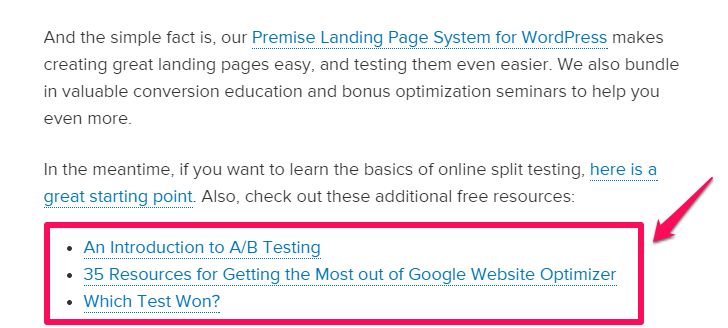
I strongly believe that the site owners didn’t do anything to get those editorial links.
They simply earned the links because of the usefulness of their content. Focus on exceptional content if you want to earn links that will improve the rank of your web pages.
Scale link building: Link diversity is the ultimate way to generate Google-friendly links and improve Google rankings while staying off the penalty radar.
This tutorial from SEMrush will show you how to ethically build links to improve Google ranking.
Old techniques, like directory submission, forum marketing, wiki sites, and even guest blogging and press releases don’t work and they also put you at risk for a Google penalty.
To get a diverse inbound link profile, write page content that will gain links from local, regional, and international sites relevant to your own.
Then, you’ll build a natural link profile with natural, targeted on-page SEO that will withstand anything Google throws at it.
Step 10: Get Active on Social Media
What does social media have to do with search rankings?
That’s a great question.
Search engines like Google try to take into account as much information as possible about your website.
They use it to determine the quality of your website and thus where they should place you when someone searches regarding a topic within your niche.
One of the factors that search engines consider is social media. In particular, they consider the following questions:
- How active are your social media accounts?
- How up-to-date are your social media accounts?
- How many shares does your website content get on social media?
On top of all that, keep in mind that social media also offers 4.8 billion social media users worldwide. That’s a lot of traffic potential.
It’s not just worth it for the sake of reaching a larger audience on the social media platform itself; social media can drive traffic to your site, which improves your search ranking.
How do you share content on social media that users are likely to share?
Here’s one great tactic: when you share stuff on social media, you want to increase your audience size and encourage people to engage with your content.
To do that, you can tag some of your friends who you think might be interested in the content.
This doesn’t just show the post to people you tagged. It also ensures that Facebook will show your post to all of the friends of those you’ve tagged.
You can easily increase your audience size by several thousand with a few relevant tags.
However you do it, use social media to build your SEO. The search engines are watching. Start performing.
Frequently Asked Questions About How to Improve Google Rankings Without Penalties
What is the top way to improve your Google ranking?
The most effective way to improve your ranking is to do keyword research and write content that is highly relevant for user intent associated with those keywords.
How long does it take for Google to rank your content?
It can take up to six months to have your content appear in the search results.
Is it possible to rank in the top results on Google for Free?
What are some strategies to rank on Google that are penalized?
You can be penalized for things like duplicate content, over-optimization, and bad linking practices.
How to Improve Google Rankings Without Penalties Conclusion
The key to higher Google rankings without getting slapped with a penalty boils down to providing useful content, presented in a helpful way.
A few basic include:
- Take the time truly understand your target audience and their desires.
- Do the research needed to identify the long-tail keywords they’re using to get to your site.
- Once you have this info, you can create killer content to meet their needs, solve their problems, and keep them coming back for more.
- Keep churning out great content and promoting it with all you’ve got.
Lather, rinse, repeat, and you’ll dominate search engines while avoiding Google penalties from algorithm updates.
How did your site do in the most recent Google update? Did you see any change in rankings, traffic, and conversions?
See How My Agency Can Drive Massive Amounts of Traffic to Your Website
- SEO – unlock massive amounts of SEO traffic. See real results.
- Content Marketing – our team creates epic content that will get shared, get links, and attract traffic.
- Paid Media – effective paid strategies with clear ROI.
AI
Exploring the Evolution of Language Translation: A Comparative Analysis of AI Chatbots and Google Translate

According to an article on PCMag, while Google Translate makes translating sentences into over 100 languages easy, regular users acknowledge that there’s still room for improvement.
In theory, large language models (LLMs) such as ChatGPT are expected to bring about a new era in language translation. These models consume vast amounts of text-based training data and real-time feedback from users worldwide, enabling them to quickly learn to generate coherent, human-like sentences in a wide range of languages.
However, despite the anticipation that ChatGPT would revolutionize translation, previous experiences have shown that such expectations are often inaccurate, posing challenges for translation accuracy. To put these claims to the test, PCMag conducted a blind test, asking fluent speakers of eight non-English languages to evaluate the translation results from various AI services.
The test compared ChatGPT (both the free and paid versions) to Google Translate, as well as to other competing chatbots such as Microsoft Copilot and Google Gemini. The evaluation involved comparing the translation quality for two test paragraphs across different languages, including Polish, French, Korean, Spanish, Arabic, Tagalog, and Amharic.
In the first test conducted in June 2023, participants consistently favored AI chatbots over Google Translate. ChatGPT, Google Bard (now Gemini), and Microsoft Bing outperformed Google Translate, with ChatGPT receiving the highest praise. ChatGPT demonstrated superior performance in converting colloquialisms, while Google Translate often provided literal translations that lacked cultural nuance.
For instance, ChatGPT accurately translated colloquial expressions like “blow off steam,” whereas Google Translate produced more literal translations that failed to resonate across cultures. Participants appreciated ChatGPT’s ability to maintain consistent levels of formality and its consideration of gender options in translations.
The success of AI chatbots like ChatGPT can be attributed to reinforcement learning with human feedback (RLHF), which allows these models to learn from human preferences and produce culturally appropriate translations, particularly for non-native speakers. However, it’s essential to note that while AI chatbots outperformed Google Translate, they still had limitations and occasional inaccuracies.
In a subsequent test, PCMag evaluated different versions of ChatGPT, including the free and paid versions, as well as language-specific AI agents from OpenAI’s GPTStore. The paid version of ChatGPT, known as ChatGPT Plus, consistently delivered the best translations across various languages. However, Google Translate also showed improvement, performing surprisingly well compared to previous tests.
Overall, while ChatGPT Plus emerged as the preferred choice for translation, Google Translate demonstrated notable improvement, challenging the notion that AI chatbots are always superior to traditional translation tools.
Source: https://www.pcmag.com/articles/google-translate-vs-chatgpt-which-is-the-best-language-translator
Google Implements Stricter Guidelines for Mass Email Senders to Gmail Users

Beginning in April, Gmail senders bombarding users with unwanted mass emails will encounter a surge in message rejections unless they comply with the freshly minted Gmail email sender protocols, Google cautions.
Fresh Guidelines for Dispatching Mass Emails to Gmail Inboxes In an elucidative piece featured on Forbes, it was highlighted that novel regulations are being ushered in to shield Gmail users from the deluge of unsolicited mass emails. Initially, there were reports surfacing about certain marketers receiving error notifications pertaining to messages dispatched to Gmail accounts. Nonetheless, a Google representative clarified that these specific errors, denoted as 550-5.7.56, weren’t novel but rather stemmed from existing authentication prerequisites.
Moreover, Google has verified that commencing from April, they will initiate “the rejection of a portion of non-compliant email traffic, progressively escalating the rejection rate over time.” Google elaborates that, for instance, if 75% of the traffic adheres to the new email sender authentication criteria, then a portion of the remaining non-conforming 25% will face rejection. The exact proportion remains undisclosed. Google does assert that the implementation of the new regulations will be executed in a “step-by-step fashion.”
This cautious and methodical strategy seems to have already kicked off, with transient errors affecting a “fraction of their non-compliant email traffic” coming into play this month. Additionally, Google stipulates that bulk senders will be granted until June 1 to integrate “one-click unsubscribe” in all commercial or promotional correspondence.
Exclusively Personal Gmail Accounts Subject to Rejection These alterations exclusively affect bulk emails dispatched to personal Gmail accounts. Entities sending out mass emails, specifically those transmitting a minimum of 5,000 messages daily to Gmail accounts, will be mandated to authenticate outgoing emails and “refrain from dispatching unsolicited emails.” The 5,000 message threshold is tabulated based on emails transmitted from the same principal domain, irrespective of the employment of subdomains. Once the threshold is met, the domain is categorized as a permanent bulk sender.
These guidelines do not extend to communications directed at Google Workspace accounts, although all senders, including those utilizing Google Workspace, are required to adhere to the updated criteria.
Augmented Security and Enhanced Oversight for Gmail Users A Google spokesperson emphasized that these requisites are being rolled out to “fortify sender-side security and augment user control over inbox contents even further.” For the recipient, this translates to heightened trust in the authenticity of the email sender, thus mitigating the risk of falling prey to phishing attempts, a tactic frequently exploited by malevolent entities capitalizing on authentication vulnerabilities. “If anything,” the spokesperson concludes, “meeting these stipulations should facilitate senders in reaching their intended recipients more efficiently, with reduced risks of spoofing and hijacking by malicious actors.”
Google’s Next-Gen AI Chatbot, Gemini, Faces Delays: What to Expect When It Finally Launches

In an unexpected turn of events, Google has chosen to postpone the much-anticipated debut of its revolutionary generative AI model, Gemini. Initially poised to make waves this week, the unveiling has now been rescheduled for early next year, specifically in January.
Gemini is set to redefine the landscape of conversational AI, representing Google’s most potent endeavor in this domain to date. Positioned as a multimodal AI chatbot, Gemini boasts the capability to process diverse data types. This includes a unique proficiency in comprehending and generating text, images, and various content formats, even going so far as to create an entire website based on a combination of sketches and written descriptions.
Originally, Google had planned an elaborate series of launch events spanning California, New York, and Washington. Regrettably, these events have been canceled due to concerns about Gemini’s responsiveness to non-English prompts. According to anonymous sources cited by The Information, Google’s Chief Executive, Sundar Pichai, personally decided to postpone the launch, acknowledging the importance of global support as a key feature of Gemini’s capabilities.
Gemini is expected to surpass the renowned ChatGPT, powered by OpenAI’s GPT-4 model, and preliminary private tests have shown promising results. Fueled by significantly enhanced computing power, Gemini has outperformed GPT-4, particularly in FLOPS (Floating Point Operations Per Second), owing to its access to a multitude of high-end AI accelerators through the Google Cloud platform.
SemiAnalysis, a research firm affiliated with Substack Inc., expressed in an August blog post that Gemini appears poised to “blow OpenAI’s model out of the water.” The extensive compute power at Google’s disposal has evidently contributed to Gemini’s superior performance.
Google’s Vice President and Manager of Bard and Google Assistant, Sissie Hsiao, offered insights into Gemini’s capabilities, citing examples like generating novel images in response to specific requests, such as illustrating the steps to ice a three-layer cake.
While Google’s current generative AI offering, Bard, has showcased noteworthy accomplishments, it has struggled to achieve the same level of consumer awareness as ChatGPT. Gemini, with its unparalleled capabilities, is expected to be a game-changer, demonstrating impressive multimodal functionalities never seen before.
During the initial announcement at Google’s I/O developer conference in May, the company emphasized Gemini’s multimodal prowess and its developer-friendly nature. An application programming interface (API) is under development, allowing developers to seamlessly integrate Gemini into third-party applications.
As the world awaits the delayed unveiling of Gemini, the stakes are high, with Google aiming to revolutionize the AI landscape and solidify its position as a leader in generative artificial intelligence. The postponed launch only adds to the anticipation surrounding Gemini’s eventual debut in the coming year.
-

 WORDPRESS7 days ago
WORDPRESS7 days ago10 WordPress Influencers to Follow in 2024 – WordPress.com News
-

 SEARCHENGINES7 days ago
SEARCHENGINES7 days agoGoogle Image Search Adds Pixel Level Object Segmentation Animation
-

 MARKETING7 days ago
MARKETING7 days agoFeeling Stuck: What to Do When You Don’t Know What to Do
-

 PPC5 days ago
PPC5 days agoA History of Google AdWords and Google Ads: Revolutionizing Digital Advertising & Marketing Since 2000
-

 SEARCHENGINES6 days ago
SEARCHENGINES6 days agoMore Google March 2024 Core Update Ranking Volatility
-

 PPC6 days ago
PPC6 days agoCompetitor Monitoring: 7 ways to keep watch on the competition
-

 PPC6 days ago
PPC6 days ago31 Ready-to-Go Mother’s Day Messages for Social Media, Email, & More
-

 WORDPRESS6 days ago
WORDPRESS6 days agoThrive Architect vs Divi vs Elementor














